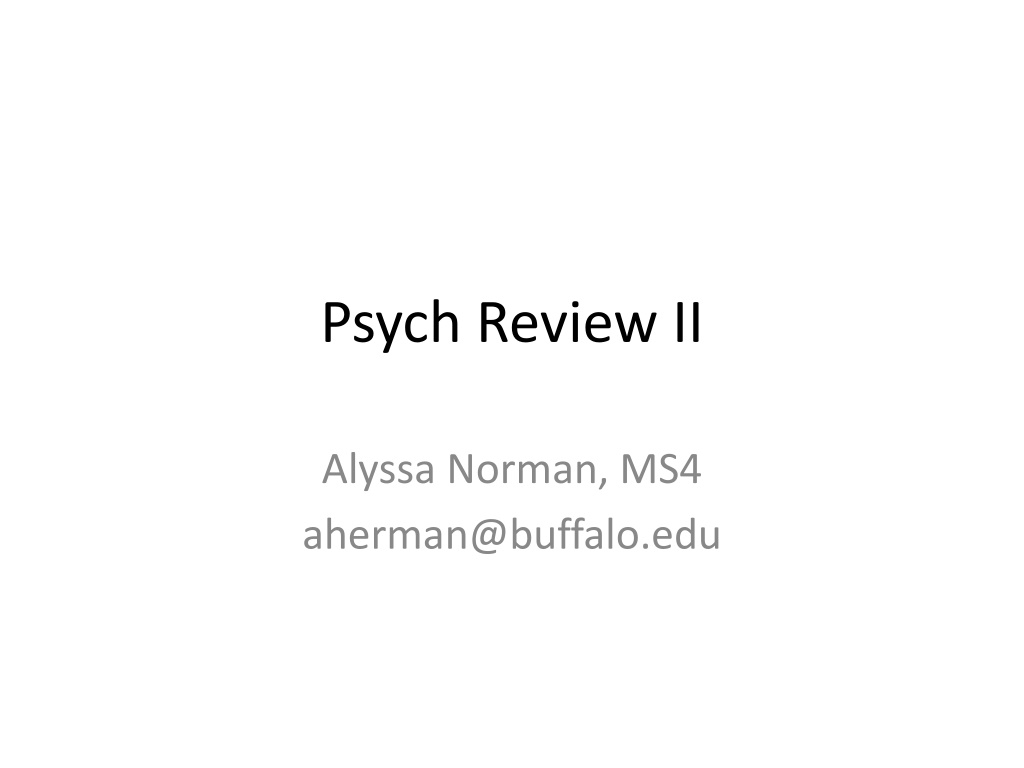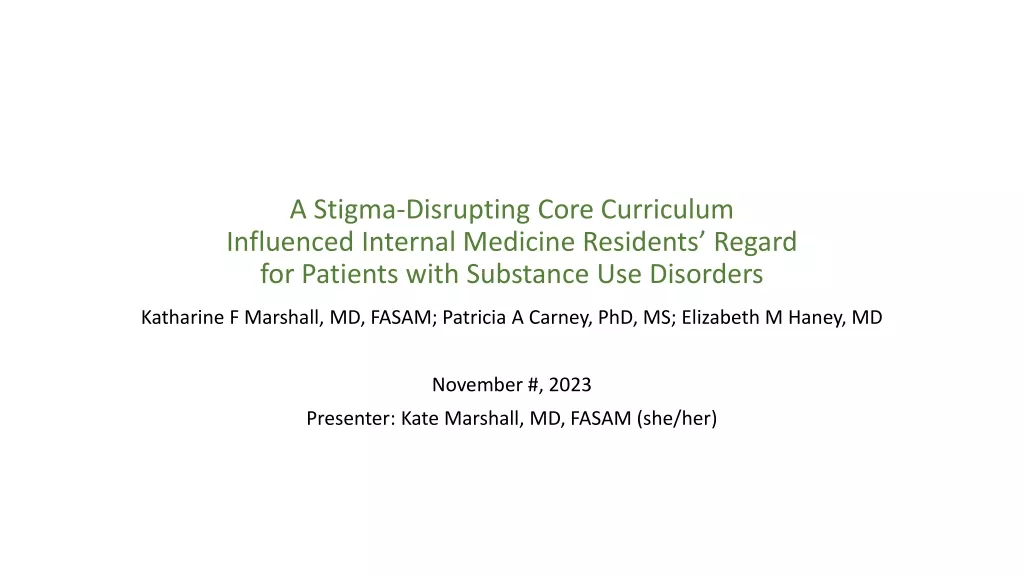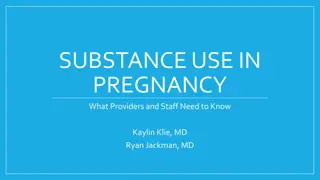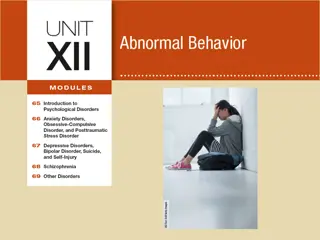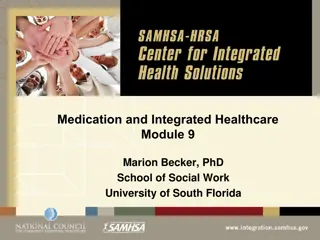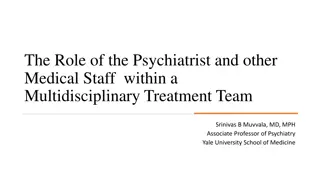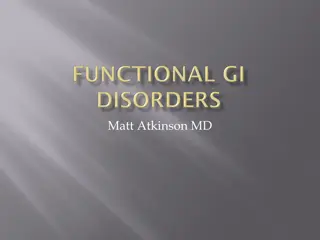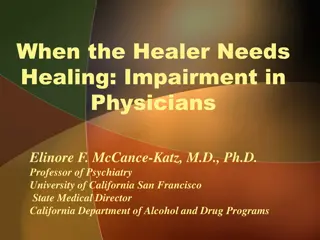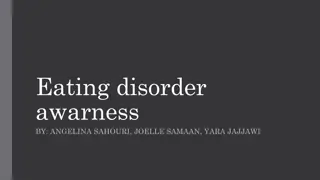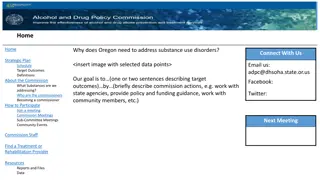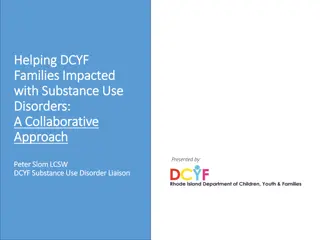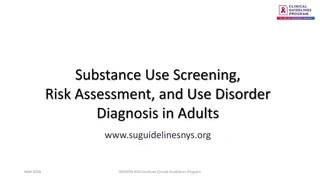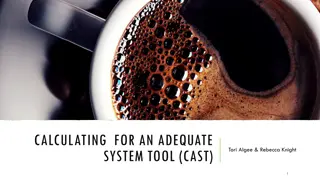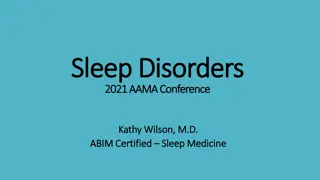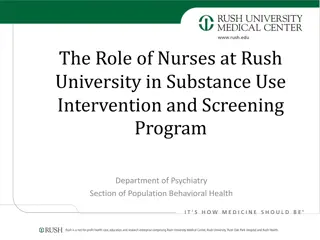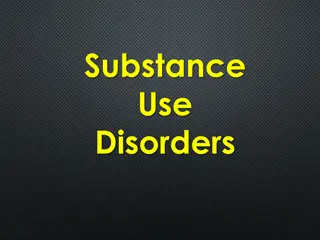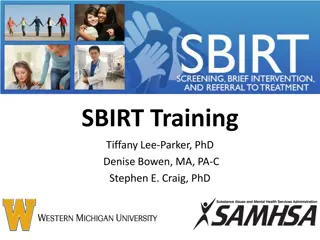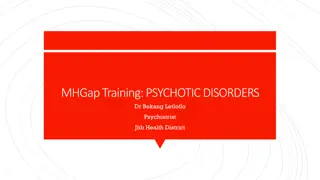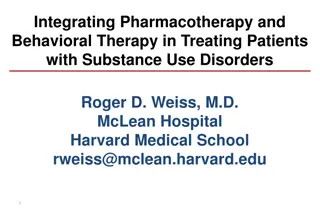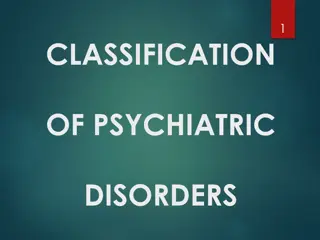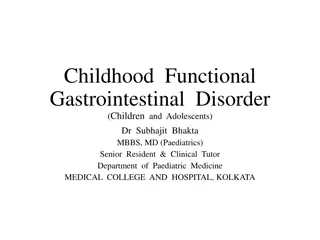Substance Use Disorders and Their Effects
Alyssa Norman, MS4, provides a comprehensive review of intoxication and withdrawal patterns in substance use disorders, highlighting impaired control, social impairment, risky use, and pharmacologic dependence. The content covers various substances, mechanisms of action for stimulants, symptoms of intoxication and withdrawal, and treatment approaches for stimulant-related conditions, dissociative anesthetics, and hallucinogens.
Download Presentation

Please find below an Image/Link to download the presentation.
The content on the website is provided AS IS for your information and personal use only. It may not be sold, licensed, or shared on other websites without obtaining consent from the author.If you encounter any issues during the download, it is possible that the publisher has removed the file from their server.
You are allowed to download the files provided on this website for personal or commercial use, subject to the condition that they are used lawfully. All files are the property of their respective owners.
The content on the website is provided AS IS for your information and personal use only. It may not be sold, licensed, or shared on other websites without obtaining consent from the author.
E N D
Presentation Transcript
Psych Review II Alyssa Norman, MS4 aherman@buffalo.edu
Intoxication & Withdrawal Substance Use Disorder problematic pattern of substance use leading to significant impairment or distress over 12 month period involving: Impaired Control can t cut down, taking more than intended Social Impairment not fulfilling obligations, giving up important activities Risky Use ignoring hazardous purchasing conditions or physical effects Pharmacologic Dependence tolerance, withdrawal if stop using
Intoxication & Withdrawal Dissociative Anesthetics Stimulants Sedatives Hallucinogens Cannabinoids Cocaine Alcohol LSD PCP Marijuana Amphetamines Psilocybin Ketamine K2 Benzodiazepines Crystal Meth Barbituates Mescaline MDMA (Ecstasy) Opioids Bath Salts
Stimulants Mechanisms of Action: Cocaine reuptake of DA, NE, 5HT Smoking and injection = most addictive Also block nerve impulses causing local anesthetic effect Amphetamines reuptake, release, degradation of NE and DA Ecstasy amphetamine MoA + release of 5HT Crystal Meth fat solubility BBB penetration more addictive Bath Salts effect is similar to amphetamines
Stimulants Intoxication sympathomimetic ( HR, BP, RR), mydriasis, euphoria Cocaine overdose formications, delirium, seizure, stroke, MI Ecstasy emotional openness, euphoria, afterglow Withdrawal malaise, fatigue, depression, SI, hypersomnia, miosis Symptomatic treatment Ecstasy long-term use can deplete 5HT depression
Dissociative Anesthetics PCP MoA: blocks NMDA glutamate receptors, activates DA receptors Intoxication: hallucinations, nystagmus, violence, anesthesia Overdose: fever, rhabdo, renal failure, seizure, respiratory depression, death Treatment: isolate, benzos, urine acidification (NOT antipsychotics can worsen psychosis) Ketamine Hallucinations, dissociation, profound respiratory depression
Hallucinogens LSD, Psilocybin, Mescaline MoA 5HT receptor agonist Intoxication visual distortions, intense emotions, mydriasis, tachycardia, altered sense of time/space Hallucinogen Persisting Perception ( Bad Trip ) acute anxiety reaction Tx reassurance and wait, +/- benzos, antipsychotics last resort Flashbacks can occur in times of fatigue/stress or while using other drugs Duration LSD, mescaline: 6-10 hrs Psilocybin 2-4 hrs
Cannabinoids Marijuana (Cannabis) MoA THC binds endogenous cannabinoid receptors Intoxication euphoria, relaxation, conjunctival injection, paranoia, increased appetite Withdrawal irritability, restlessness, anxiety, depressed mood, abdominal pain K2 (Spice) Synthetic cannabinoid, 10x more affinity for receptor than THC More severe sxs hallucinations, thought disorganization, aggression
Sedatives Alcohol, Benzodiazepines, Barbituates MoA potentiates the effects of GABA (CNS depressant) Intoxication incoordination, slurred speech, nystagmus, coma Benzo overdose flumazenil Withdrawal LIFE THREATENING!!!! Autonomic hyperactivity, tremor, seizures, DTs (day 2- 3) Tx frequent vitals, benzo taper, carbamazepine
Sedatives Opioids Heroin, Methadone, Buprenorphine, Naloxone, Naltrexone MoA bind opioid receptors (most importantly the Mu receptors) Full agonist: highly reinforcing, most common to abuse Heroin, methadone, oxycodone Partial agonists: activates at lower levels, less reinforcing Buprenorphine Antagonist: occupies without activating, not reinforcing, blocks and displaces agonists Naloxone, naltrexone
Opioids Intoxication euphoria, analgesia, respiratory depression, miosis, constipation Overdose can be fatal treat with naloxone (antagonist) Single naloxone lasts 1-4hrs Withdrawal dysphoria, craving, nausea/vomting, diarrhea, lacrimation, rhinorrhea, yawing, mydriasis Treatments for dependence Methadone: used for detox and maintenance, long half-life Suboxone (buprenorphine/naloxone) detox and maintenance Naltrexone maintenance only
Features changes in: Mood Thought Vegetative function Depression Major Depressive Episode (MDE) 5 or more of the following for 2 weeks, with loss of function: Epidemiology: ~2:1 female to male Increased incidence Decreased age of onset 2-4% community prevalence Depressed mood* Sleep disturbance Interest lost (anhedonia)* Guilt/worthlessness Energy loss Concentration loss Appetite change Psychomotor agitation/retardation Suicidal Ideation Etiology Genetic Environmental Course 50% recurrence after 1 episode Risk of recurrence increases with more/longer episodes *Need both (SIGECAPS)
Depression Physiologic Changes: Dysregulated stress response ( cortisol) Neuronal atrophy, NT imbalances Sleep: REM latency, slow wave sleep (restorative sleep) In children: Irritability, apathy, behavioral change Less of a response to antidepressants More likely to have bipolar outcome
Depression Diagnoses Major Depressive Disorder (MDD) at least 1 major depressive episode ( 2 weeks) MDD with atypical features: increased sleep, increased appetite, weight gain MDD with psychotic features: w/ delusions and/or hallucinations Tx antipsychotic + antidepressant Dysthymia milder depressive symptoms for 2 years Seasonal Affective Disorder depression ONLY in winter, normal or hypomanic in spring Secondary Depression: General medical condition hypothyroidism ,pancreatic cancer, left hemisphere stroke, Parkinson's, HIV, autoimmune Medication/substance alcohol, steroids
Treatments for Depression 1st Line = SSRIs (fluoxetine, sertraline, paroxetine, fluvoxamine, citalopram, escitalopram) inhibit 5HT reuptake Side effects sexual dysfunction, GI disturbance, headaches, sedation/activation Paroxetine more anticholinergic, contraindicated in pregnancy TCAs (amitriptyline, nortriptyline, clomipramine) NE and 5HT reuptake inhibitors Uses: migraines, chronic pain, refractory depression (not 1st line) Side effects: anticholinergic, orthostatic hypotension, heart block, lethal in OD Toxicity: Cardic, CNS/Convulsions, Coma MAOIs (phenelzine, isocarboxazid) prevent MAO from breaking down NE, 5HT, DA and tyramine Uses refractory and atypical depression CANNOT combine with SSRIs (serotonin syndrome) or tyramine-rich foods (cheese, wine, chocolate, fava beans (HTN crisis)
Treatments for Depression Trazodone 5HT antagonist Sedating, risk of priapism Buproprion DA and NE reuptake inhibitor Less sexual side effects (vs. SSRIs), risk of seizures at high doses DA reuptake inhibition makes it first choice for depressed Parkinson s patients Venlafaxine 5HT, NE, DA reuptake inhibitor Useful for depression with chronic pain Hypertension risk, short half-life (withdrawal) Mirtazepine 5HT and alpha2 antagonist Causes sedation and weight gain ideal for depressed cancer patients ECT electroconvulsive therapy Most effective therapy, main side effect is transient amnesia
Principles of Treatment Start low, go slow If no response in 4 weeks switch to something else in same class It can take up to 6-8 weeks for full therapeutic effect Continue 8-12 months for first episode of mild depression Indefinitely if recurrent or severe first episode Remember antidepressants in general work by altering second messenger systems with up-regulate neuroprotective genes
Bipolar Disorder Mania elevated/expansive/irritable mood with 3-4+ symptoms for 1 week Distractibility Indiscretion Grandiosity Flight of ideas Activity increased Sleep decreased Talkative (pressured speech) Hypomania same symptom criteria as above EXCEPT: 4 days duration No marked functional impairment Hospitalization not required No psychotic features Additional Characteristics of Mania: Severe impairment in function May include psychotic features Frequently requires hospitalization (which confirms diagnosis regardless of symptom time frame)
Bipolar Diagnoses Bipolar I at least 1 manic episodes (Required) + major depressive episode (not required) Bipolar II at least 1 hypomanic episode + at least 1 major depressvive episode Cyclothymia - 2 years of mood swings between hypomania and mild depressive (dysthymia) symptoms Mixed Episode simultaneous manic/hypomanic and depressive symptoms Secondary Mania: General medical condition hyperthyroidism, right hemisphere stroke Medications/substance antidepressants, stimulants, steroids
Remember Schizoaffective Disorder? Schizoaffective Disorder concurrent symptoms of schizophrenia and mood disorder but with at least 2 weeks of psychotic symptoms in the absence of mood symptoms In mood disorders with psychotic features, psychosis never occurs outside the context of the mood symptoms (mood symptoms are causing the psychosis) If mood symptoms disappear, but psychosis remains for at least 2 weeks on their own = Schizoaffective disorder
Bipolar Disorder Epidemiology ~1% prevalence of Bipolar I 67-100% concordance between MZ twins (risk only dependent on biological family) Oligogenetic When to think of Bipolar vs. Depression Family hx Early (childhood) onset of depression Atypical depression or depression w/ psychotic features Highly recurrent episodes of depression Thrill seeking, tendency towards irritability or impulsivity Arrogance or intrusiveness, high-functioning/creative
Treatment for Bipolar Disorder Aka. Mood Stabilizers Lithium* Narrow therapeutic index, can improve depression Side effects cognitive impairment, weight gain, renal/thyroid dysfunction Carbamazepine* Better tolerated than Li, useful for rapid cycling, can improve depression Side effects sedation, neurotoxicity, SIADH, agranulocytosis (Rare) Valproic Acid/Divaplroex* Good for anxiety and anti-aggression, but no antidepressant effect Side effects sedation, weight gain, cognitive impairment, pancreatitis Atypical antipsychotics Treat acute mania, possible adjunct to maintenance *Teratogenic
Suicide Risk factors: previous attempt, substance abuse, mental illness, firearms in the home, elderly, military personnel Native American > White > Asian, Hispanic, Black Females attempt more (3:1), males complete more (4:1) Firearms = most common in U.S. and most lethal Hospitalize (involuntarily if necessary), begin appropriate therapy SSRI s when starting there is a higher suicide risk (energy levels improve before depressed mood/suicidal thought content)
Eating Disorders Sense of lack of control Feelings shame/embarrassment during/after binge More ego-dystonic more likely to present Parotitis, enamel erosion, dorsal hand calluses, hypokalemic hypochloremic metabolic alkalosis Tx fluoxetine if comorbid depression, CBT Binge-eating disorder Binge-eating (at least 1x/week for 3 months) with no compensatory behavior Normal or overweight Anorexia Nervosa Persistent energy intake restriction Intense fear of gaining weight Disturbance of body image Underweight BMI < 17.5, < 85% expected weight Tend to be controlling, perfectionistic, inflexible More ego-syntonic less likely to present themselves to treatment HR/BP/Temp, ECG changes, electrolyte abnormalities, osteopenia, lanugo Types: restricting, binge-eating/purging Tx therapy, strict weight gain programs, potential hospitalization Bulimia Nervosa Recurrent episodes of binge eating Compensatory behavior vomiting, laxatives, excessive exercise Disturbance of body image Normal or overweight
Gender Dysphoria A marked incongruence between one s experienced/expressed gender and assigned gender for 6 months duration, with 2 of the following: Marked incongruence between one s experienced/expressed gender and primary +/or secondary sex characteristics Strong desire to be rid of one s primary +/or secondary sex characteristics because of a marked incongruence with one s experienced/expressed gender Strong desire for the primary +/or secondary sex characteristics of the other gender Strong desire to be of the other gender Strong desire to be treated as the other gender Strong conviction that one has the typical feelings and reactions of the other gender Associated with clinically significant distress or impairment in social, occupational or other important areas of functioning
Gender Dysphoria - Differential Transvestic Disorder cross dressing behavior generates sexual excitement or distress/impairment without drawing primary gender into question Body Dysmorphic Disorder individual focuses on alteration or removal of specific body part perceived to be abnormal (not because it represents assigned gender)
Medical Causes PE Arrhythmia CHF Delirium Dementia Substance Causes Stimulants Caffeine Nicotine Alcohol Antidepressants Other Psych Conditions Depression Bipolar Schizophrenia Anxiety Disorders Generalized Anxiety Disorder excessive worry about multiple everyday events for > 6 months Restlessness, easily fatigued, concentration, irritability, muscle tension, sleep disturbance Panic Disorder recurrent, unprovoked episodes of intense fear (panic attacks) Tachycardia, sweating, SOB, CP, abdominal distress, tremor, dizziness Anticipatory anxiety for future attacks, fear losing control , significant change in behavior Peak in 10 mins, last 20-30 mins Agoraphobia fear of being in situations from which escape may be difficult Being outside the home, in a crowd or in line, bridges tunnels, on a bus, train or car Specific Phobia persistent, irrational fear of object, creature or situation Social Phobia (Social Anxiety Disorder) anxiety about humiliating oneself in both social and performance situations
Risk factors: Female gender, younger age Low SES, education, IQ Intentional violent act toward you, trauma severity Continued environmental exposures PTSD and ASD Post-traumatic Stress Disorder Experiencing/witnessing/learning of a traumatic event, with 1 month of symptoms (onset at any time) from the following clusters + functional impairment: Intrusion flashbacks, nightmares, distressing thoughts Avoidance physical (people, places) or mental (thoughts, feelings) Cognition/Mood persistent negative emotions, detachment, distorted cognition (irrational thoughts) Arousal/Reactivity hype vigilance, startle response, sleep disturbance, irritability Acute Stress Disorder Similar scenario and symptomatology to PTSD except: Duration is 3 days 1 month after trauma exposure Functional Consequences: Substance abuse Aggression/violence SI, attempts Work/marriage problems Treatments: CBT (1st line), EMDR SSRI s (1st line) sertraline, paroxetine Benzos (Very short term) Prazosin for nightmares
Neuroscience of PTSD Amygdala hyperactive Hyperarousal, exaggerated emotional response to stimuli Prefrontal cortex hypoactive ability to keep limbic system in check ability to properly interpret stimulus context behaviors become more instinctual memory consolidation which links context to stimulus Hippocampus small Also impairs memory formation which properly links context to stimulus NE hyperactivity (made in locus coeruleus) Increased sympathetic tone increased HR, BP, startle response, hyperarousal HPA axis dysregulation on the locus coeruleus high levels of stress hormones (i.e. cortisol) fail to provide feedback inhibition continues to drive up NE levels
Anxiolytics Benzodiazepines (diazepam, alprazolam, etc) acute anxiety Potentiate GABA neuron hyperpolarization reduce anxiety Side effects sedation, impaired coordination, life-threatening withdrawal Antidepressants (SSRIs) 1st line for chronic anxiety (i.e. GAD) Buspirone chronic anxiety 5HT partial agonist Non-sedating, no withdrawal, no impairment of driving Propranolol performance anxiety Prazosin alpha blocker that BP and improves sleep (sedating, nightmares) Non-pharmacologic treatments relaxation training, desensitication, CBT (especially for insomnia)
Somatic Symptom Disorders Somatization psychological problems communicated as physical symptoms which are otherwise medically unexplained or disproportionate Risks childhood illness, parental illness, childhood trauma/abuse Consequences increase health care visits, increase iatrogenic disease due to unnecessary workup, disruption of doctor-patient relationship Somatic Symptom Disorder 1 or more somatic symptoms that are distressing Excessive thoughts/feelings/behaviors related to the symptoms Disproportionte/persistend thoughts about seriousness of symptoms Persistently high anxiety level Excessive time/energy devoted to symptoms or health concerns Symptom duration 6 months Tx regular f/u visits (i.e monthly), set limits, minimize polypharmacy, treat common comorbid conditions appropriately (depression/anxiety disorders)
Somatic Symptom Disorders Illness Anxiety Disorder Excessive/disproportionate preoccupation with having/acquiring a serious illness High anxiety level about health, illness becomes central to identity, seek reassurance No (or mild) somatic symptoms Illness preoccupation present for 6 months Conversion Disorder One or more neurologic (sensory or motor) symptoms which cannot be explained by a known neurological/medical condition Weakness/paralysis, reduced sensation, dysarthria, limb shaking/pseudo seizures Abrupt onset, short duration Women > men La Bell Indifference Factitious Disorder (Munchhausen Syndrome) Conscious falsification of physical/psych symptoms for primary gain (i.e sick role) No obvious external rewards (vs. malingering falsify for secondary gain) Munchhausen Syndrome by proxy falsifying symptoms of another individual
OCD Spectrum Disorders Obsessions recurrent and persistent thoughts/urges/images experienced as intrusive and unwanted (ego-dystonic) and cause anxiety/distress Common themes contamination, fear of harming, need for symmetry, checking for reassurance Compulsions repetitive behaviors (washing, checking) or mental acts (counting, repeating) that the individual feels driven to perform to alleviate anxiety from obsessions or prevent a dreaded event Obsessive-Compulsive Disorder Presence of obsessions, compulsions or both Time consuming (>1hr/day) or causes significant distress/impaired function MRI findings increased metabolic activity in orbitofrontal cortex, limbic structures, caudate, and thalamus (regulate emotions, impulse inhibition and judgment) M=F, younger in males, 80-87% MZ concordance, childhood onset comorbid with Tourette s Syndrome, ADHD Tx CBT (1st line), SSRIs, clomipramine (TCA), surgical treatments (gamma knife, DBS)
OCD Spectrum Disorders Compulsive Hoarding acquisition of and/or failure to discard useless/valueless possessions Cluttered living space, social isolation, impaired functioning or significant distress/shame, difficulty with decision making Can be symptom of OCD or a stand-alone dx (70-80% meet OCD criteria) Vs. OCD earlier symptom onset, age at presentation, insight, more tx-resistant Tx same as OCD (CBT, SSRIs) Body Dysmorphic Disorder preoccupation with perceived physical flaws that are slight/unobservable to others Skin, hair nose are common preoccupations Repetitive behaviors (grooming, mirror checking) or mental acts (comparing to others) Often have intrusive, obsessive thoughts Clinically significant distress or impaired function Ideas of reference common falsely believe people are judging/mocking them High rates of SI and attempts
